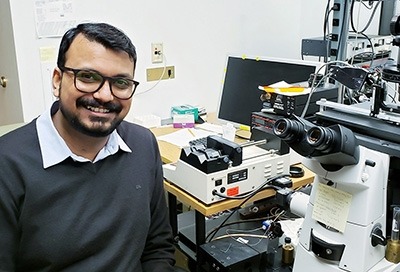How Oral Bacteria Build Microbial Communities
Our bodies are home to trillions of microbes that help strike the balance between health and disease. But the microorganisms housed in and on us can’t just settle into any nook or cranny. As in real estate, location matters. When bacteria find a spot well-suited to their biology, they can assemble into highly organized communities–such as biofilms–that may help the microbes but harm human health.
An NIDCR-supported study published in Proceedings of the National Academy of Sciences now reports that common oral bacteria can shape their communities in part by their ability to glide over surfaces and transport other types of bacteria that can’t move on their own. These gliding processes may contribute to formation of oral biofilms such as plaque, the sticky layers of bacteria that form on unbrushed teeth. According to study author and Harvard postdoctoral researcher Abhishek Shrivastava, PhD, understanding how such bacterial communities form could lead to new ways to prevent or treat a variety of conditions, including periodontal disease.
Shrivastava began his postdoctoral work studying a molecular motor system that enables Flavobacteria, a genus of soil and water microbes, to propel themselves via gliding. He soon learned that an identical motor system was found in a different type of bacteria, Capnocytophaga gingivalis, prevalent in human gingiva (gums) and oral biofilms. Shrivastava wondered if C. gingivalis also moved by gliding and if so, what role the gliding bacteria play in the oral cavity.
Having never worked in oral microbiology and unsure where to start, Shrivastava contacted Leslie Frieden, PhD, a program officer in NIDCR’s Research Training and Career Development Program. With Frieden’s advice and encouragement, Shrivastava successfully applied for a Pathway to Independence Award (K99/R00), a funding method that helps outstanding postdoctoral scholars transition to independent research careers.
Shrivastava found NIDCR-funded oral microbiome researchers at the Forsyth Institute in nearby Cambridge, Massachusetts, who gave him a sample of C. gingivalis taken from human periodontal lesions. Shrivastava grew the bacteria and viewed them under the microscope. Just as suspected, he says, “the bacteria were gliding across the slide, very similar to how the Flavobacteria behaved.”
Follow the Bubbles
Shrivastava and colleagues set out to more thoroughly document the behavior of C. gingivalis. The researchers spread tiny, micron-sized air bubbles across a gelatinous (agar) surface and then added the bacteria. The bacteria secreted chemicals that resulted in the formation of a fluid layer. The bacteria moved the fluid and buoyant air bubbles as they migrated across the agar. By tracking the bubbles’ positions and movement of the fluid, the researchers could trace the paths of the bacteria. This method showed that C. gingivalis bacteria moved together in groups, much like flowing traffic or swarms of bees. The swarms moved in counterclockwise circles and formed layers atop each other.
The scientists then designed a series of experiments to more closely replicate how C. gingivalis might behave in the oral cavity. They selected seven bacterial species that are nonmotile (unable to move on their own) and highly abundant in human gingiva. One at a time, each nonmotile species was placed with C. gingivalis on a glass surface. In each case, C. gingivalis adhered to and carried the nonmotile bacteria as cargo across the surface.
In another experiment, the researchers labeled each of the nonmotile species with different-colored fluorescent tags and placed all eight species together. Again, C. gingivalis carried the nonmotile bacteria. Within 20 minutes, the nonmotile bacteria clumped together in islands around which moved swarms of C. gingivalis.
“Our findings suggest that gliding bacteria like C. gingivalis have evolved a balance of motile and adhesive forces,” says Shrivastava. “These forces drive surface motility and cargo transport, by which the bacteria are able to shape specific structures.” These processes may underlie formation of oral biofilms.
As he wraps up his postdoctoral work, Shrivastava anticipates transitioning to his own lab and continuing to explore the forces that shape oral bacterial communities. For example, he says, “how does thickness of saliva, stiffness of tissue, or presence of periodontal disease affect the structure of a community?” With this information, it might be possible to shift the oral microenvironment from a diseased state to a healthier one.
Shrivastava credits NIDCR with helping him push outside his comfort zone: “I was driven by interesting scientific questions to move beyond my training, and I’m thankful for the opportunity to take some risks that led to a whole new line of inquiry.”
The NIH Pathway to Independence Award is designed to support outstanding postdoctoral researchers in the development of a creative research program and to foster their transitions to independent faculty positions. Learn more about NIDCR research training and career development opportunities.
Reference
Shrivastava A, Patel VK, Tang Y, Yost SC, Dewhirst FE, Berg H. Cargo transport shapes the spatial organization of a microbial community. Proc Natl Acad Sci U S A. 2018 Aug 21;115(34):8633-8638. doi: 10.1073/pnas.1808966115. Epub 2018 Aug 6.


